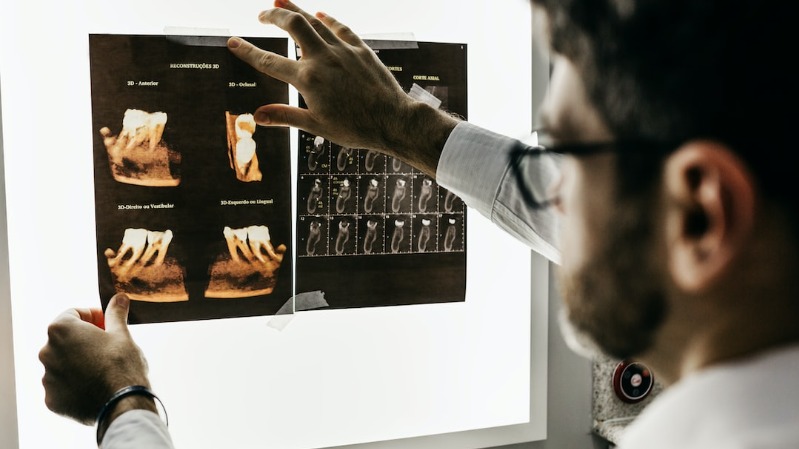
Why Do Dentists Take X-Rays?
X-rays are an essential tool used by dentists to assess the health of a patient’s teeth and jaw. The images produced by X-rays provide invaluable information about the structure of the teeth, including areas where decay or other damage has occurred; they can also reveal signs of infection or disease. Additionally, these images allow dentists to formulate an effective treatment plan for their patients.
Dentists use X-rays to detect cavities that may not be visible during a routine oral exam. These tiny holes in the enamel can be hard to spot with a visual inspection; however, X-ray imaging provides detailed views of any hidden decay or damage beneath the surface. This allows dentists to quickly identify potential problems and treat them accordingly before they become more serious.
There are many reasons that dentists take x-rays of the teeth. Some of the most common reasons are listed below.
Dentists Take X-Rays To Check For Decay Under Fillings
Contents
Sometimes decay under fillings can occur and can only be seen with a dental x-ray. It’s not uncommon for decay to recur under fillings some time after they were placed. If the filling is quite old, the edges of it can deteriorate. This allows bacteria to get under the filling and cause decay.
Examine The Area Before Procedures
Dentists need a full view of the teeth and bone before braces, implants, and tooth removal. Before undertaking some procedures, the dentist may need to take x-rays to assess and recommend the appropriate treatment thoroughly. With surgical procedures, the dentist will need to see where the nerves are to evaluate whether there are any additional risks associated with the treatment.
Look For Decay Between Teeth
To understand why dentists take X-Rays when looking for decay between teeth, it is essential first to consider the anatomy of the mouth. The human mouth comprises a complex network of soft tissue, bone, and teeth, making it difficult for dental professionals to detect underlying problems such as decay. X-rays are invaluable in helping dentists diagnose issues in areas that cannot be seen with just a visual examination.
Sometimes decay isn’t visible to the naked eye and exists in areas the dentist cannot see. In between the back teeth is commonplace for corrosion to occur. As the dentist can’t see these areas clearly, x-rays will routinely be taken to check between the teeth.
X-Rays allow dentists to see what lies beneath the surface and identify any decay present between your teeth. Decay between teeth can often go undetected if not viewed through X-Ray imaging, as even the most experienced dentist may not be able to tell from external inspection alone if damage or deterioration occurs between two adjacent teeth.
Look For Infection At The Tip Of The Root
Infections can appear at the very bottom of your teeth where the bone is, which needs to be confirmed using an x-ray. Before the treatment, the dentist will need to take an x-ray to ensure that there is an infection and to guide them on what treatment is necessary.
X-rays are essential tools for dentists, allowing them to detect infections in their patients. X-rays can reveal issues that may otherwise go unnoticed, such as cavities or infection at the tip of the root. Dentists need to take x-rays regularly to provide comprehensive and healthy treatment.
When an x-ray is taken, dentists can look closer at any potential issues they may see inside the mouth. By looking at the image produced by the x-ray, dentists can more accurately determine if there is an infection at the tip of the root of one or multiple teeth. This helps them develop a plan of action before any further damage can occur, which could result in costly repairs down the line.
Check For Bone Loss Associated With Gum Disease
Gum disease can cause bone loss; an x-ray will show how advanced it is. The x-ray will show how far the bone has shrunk back and in what parts of the mouth it is the most severe.
Gum disease is a severe issue that must be adequately treated and monitored. One of the most important steps in keeping gum disease at bay and detecting any damage that may have occurred is to get regular x-rays taken by a dentist or periodontist. X-rays are essential in evaluating bone loss caused by gum disease, which can lead to tooth loss if not treated early enough.
Dentists use x-rays to view the structures below the gums, where bone loss associated with gum disease may be hiding from view. X-rays can show cavities, impacted teeth, the bone changes around teeth, and other health issues inside your mouth before they become visible. The radiographs allow dentists to track any changes over time and ensure you receive proper care for gum disease before it progresses further.
Conclusion
Dental X-rays are invaluable for helping dentists and other healthcare professionals diagnose, treat, and prevent oral health issues. They allow for the detection of cavities, bone loss, and other problems that might otherwise go unnoticed. X-rays can also provide information about the teeth and jaw position in relation to one another. Furthermore, they are an essential tool in evaluating the success of past treatments and determining any future treatment plans or preventive measures.

